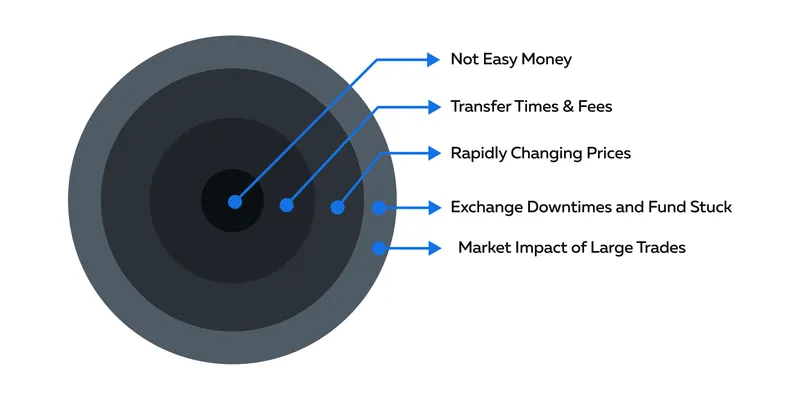20% Off Just for Blog Readers — Until July 31.
Use code BLOG20-JULY for 20% off your first month of Bookmap Only valid through July 31.
Crypto
December 25, 2024
SHARE
Crypto Pricing: Exchange Fluctuations, Arbitrage, and Finding the Right Price
In the world of cryptocurrencies, figuring out the exact value of a digital
coin isn’t a cakewalk. The prices of these digital assets constantly change
and are influenced by numerous factors. Do you want to uncover the secrets
behind how the prices of cryptocurrencies are determined?
This article will bring to light some of the fascinating complexities and
hidden dynamics that shape the value of these virtual coins. Also, explore
innovative tools to gain a competitive edge. Let’s get started.
An Overview of Crypto Pricing
In the world of cryptocurrencies, volatility is the price we pay for the
promise of higher returns and the potential for wealth creation. This is how
many crypto traders perceive the infamous price swings in the cryptocurrency
market. Multiple factors come into play when it comes to influencing crypto
pricing. Let’s gain a comprehensive understanding of them.
Factors Influencing Cryptocurrency Prices
-
Supply and Demand Dynamics
-
One of the fundamental factors affecting crypto prices is the
concept of limited supply. -
For instance, Bitcoin has a capped supply of 21 million coins,
resulting in scarcity and potentially increasing value due to a
fixed supply against rising demand.
-
-
Increasing Interest:
-
Over time, an increasing number of people are showing interest
in and adopting cryptocurrencies. -
This surge in demand has the potential to drive prices upward.
-
Apart from demand-based factors, there are some major external factors as
well:
-
Media Influence:
-
Media coverage, whether positive or negative, can significantly
impact crypto prices. -
Positive news, like endorsements by influential figures or
adoption by major companies, often leads to price increases. -
While negative news, such as regulatory crackdowns or security
breaches, can lead to rapid declines.
-
-
Governmental Regulations:
-
Announcements of new regulations or bans can trigger market
uncertainty and impact prices. -
For example, the news of
China’s crackdown on crypto mining
in mid-2021 caused a significant drop in Bitcoin prices.
-
-
Technological Updates:
-
Changes in the underlying technology of a cryptocurrency, such
as software updates or forks (like Bitcoin’s numerous forks such
as Bitcoin Cash or Bitcoin SV), can also impact prices. -
Forks can create new cryptocurrencies and even influence the
value of the original currency.
-
-
Large Whale Movements:
-
Crypto markets can be influenced by large investors or “whales”
who hold substantial amounts of a particular cryptocurrency. -
Their buying or selling activities in the market can cause
sudden price shifts due to the sheer volume of their
transactions.
-
Why Do Prices Vary Across Exchanges?

Unlike prices of securities in traditional financial markets, cryptocurrency
prices exhibit significant variations across different exchanges. This
disparity majorly happens due to the following factors:
24/7 Trading and Fragmented Nature
|
Continuous Trading |
Fragmented Trading Platforms |
|
|
Geographical Location Impact
Exchanges situated in different geographical locations experience unique
local demand and supply dynamics. Various factors influence these dynamics,
which are:
-
Regulatory environments
-
Cultural acceptance
-
Market sentiments
Additionally, varying prices across exchanges due to local market conditions
can create opportunities for geographical arbitrage. In this technique,
traders buy on one exchange where the price is lower and sell on another
where it is higher, seeking to profit from these variances.
A prime example of this type of price disparity was visible in the event of
“Kimchi Premium.”
-
The “Kimchi Premium” is a compelling illustration of significant
price disparities, particularly evident on South Korean exchanges
like Bithumb or Upbit, where prices frequently surged above the
global average. -
Sudden surges in demand within the Korean market primarily caused
this phenomenon. -
This event led to prices significantly higher than those seen on
exchanges in other parts of the world.
Arbitrage in the World of Crypto
Effective execution of
arbitrage strategies
in the crypto world requires swiftness. This is primarily due to steep price
disparities in the highly volatile cryptocurrency market. To identify
profitable arbitrage opportunities, traders and automated systems monitor
multiple exchanges and aim to benefit from market inefficiencies before they
normalize. Let’s understand this concept in detail.
Understanding Crypto Arbitrage
The Definition
Arbitrage in the context of cryptocurrencies refers to:
-
Exploiting price differences between different exchanges or
-
Timing disparities on the same exchange to make a profit.
The Process
-
Buying a cryptocurrency on one exchange where the price is lower.
-
Promptly selling it on another exchange where the price is higher.
The Allure of Arbitrage
-
The allure of crypto arbitrage lies in the potential for risk-free
profits, at least in theory. -
Unlike other trading strategies, arbitrage, when executed
successfully, can yield profits without exposure to market
volatility.
The Two Main Types of Arbitrage
|
Spatial Arbitrage |
Temporal Arbitrage |
|
|
Illustrating Crypto Arbitrage with a Hypothetical Example
-
Ethereum is priced at $2000 on Binance and $2050 on Kraken.
-
A vigilant trader identifies this price disparity and acts promptly
by executing the following steps: -
They purchase Ethereum for $2000 on Binance.
-
Simultaneously, they sell the acquired Ethereum on Kraken, where
it’s priced at $2050. -
This swift and well-coordinated transaction results in a $50 profit
per Ethereum.
Challenges & Risks with Arbitrage
Despite the profit potential, crypto arbitrage isn’t without its hurdles and
risks. Here’s an overview of the challenges involved:

-
Not “Easy Money”:
-
Arbitrage is not a guaranteed, easy money-making strategy.
-
It demands quick and precise execution.
-
-
Transfer Times and Fees:
-
Blockchain confirmation times delay transfers between exchanges.
-
This delay impacts the speed of arbitrage.
-
Additionally, fees associated with transactions, withdrawals,
and deposits can significantly eat into potential profits.
-
-
Rapidly Changing Prices:
-
Cryptocurrency markets are highly volatile, with constantly
fluctuating prices. -
An arbitrage opportunity that seems lucrative can disappear
within moments, making swift execution a necessity.
-
-
Exchange Downtimes and Fund Stuck:
-
Exchanges occasionally experience downtime, hindering the
execution of trades. -
Moreover, funds might get stuck during transfers due to issues
like network congestion or technical problems on the exchanges.
-
-
Market Impact of Large Trades:
-
Large trades involved in arbitrage can affect market prices.
-
This phenomenon, known as slippage, occurs when executing
significant transactions, causing the price to move against the
trader’s favor. -
For instance, selling a large amount of Bitcoin to exploit an
arbitrage opportunity might drive the price down, reducing or
nullifying the expected profit.
-
Finding the ‘Right’ Price for a Cryptocurrency
Gauging the value of a cryptocurrency goes beyond simply observing its price
on a single exchange. To achieve a more comprehensive and balanced
perspective of a crypto’s worth, we rely on the concept of a weighted
average price.
Weighted Average Price
|
Characteristics |
Explanation |
|
Holistic View |
|
|
Considers Exchange Volumes |
|
|
Balanced Price Evaluation |
|
Illustrating the notion of a weighted average price with a hypothetical
example
-
Bitcoin is being traded at two different prices:
-
$45,000 on a high-volume exchange like Binance.
-
$46,000 on a smaller exchange with less trading activity.
-
The weighted average price takes both of these prices into account.
-
However, it leans closer to the $45,000 mark, as Binance, with its
higher trading volume, holds more weight in the overall calculation.
Using Bookmap for Price Visualization
Do you know the biggest challenge for traders in the crypto space? It lies
in aggregating and interpreting information from many sources to gauge a
cryptocurrency’s potential price trajectory. The usage of advanced market
analysis tools like Bookmap addresses this challenge by offering a unique
feature,
“Multibook”.
The Multibook Advantage
-
Bookmap’s Multibook isn’t merely another data feed.
-
It amalgamates instruments from various cryptocurrency exchanges
into a suite of synthetic instruments. -
Such an amalgamation offers a comprehensive perspective to crypto
traders after considering the extensive number of exchanges
available.
Let’s understand some major benefits:
|
Benefits |
Explanation |
|
Visualizing Aggregated Trading Activity |
|
|
Consolidation of Order Books |
|
|
Holistic Market Understanding |
|
|
Prompt Detection of Market Aggressors |
|
|
Effortless Access to Vast Data |
|
|
Reinforcing Trust in Levels |
|
For more detailed information on Multibook and its functionalities, click
here
.
Conclusion
Determining the “right” price for cryptocurrencies is a challenging task due
to the dynamic and decentralized nature of the market. Despite efforts to
gauge a cryptocurrency’s value, the complexity and variability persist.
Thus, traders and investors must stay informed about the latest news,
regulatory changes, and market trends. Also, the utilization of modern tools
like Bookmap, having features such as Multibook, offers invaluable tools for
aggregating and visualizing data across multiple exchanges. Such tools
provide a broader understanding of market dynamics.
For those keen on capitalizing on these insights in real-time and elevating
their crypto trading strategies, Bookmap offers an advanced visualization
platform.
Sign up and begin your enhanced trading journey today
!
